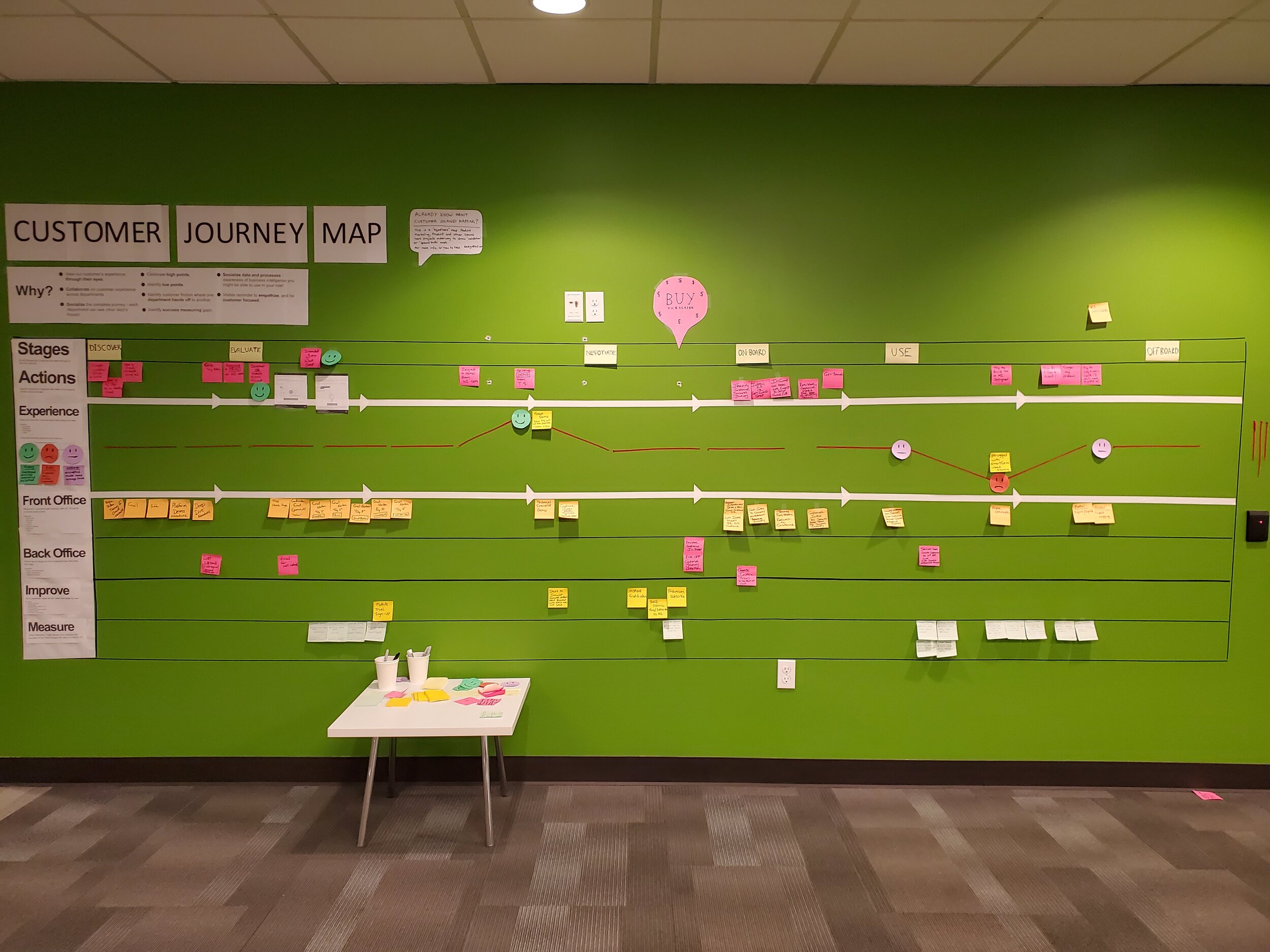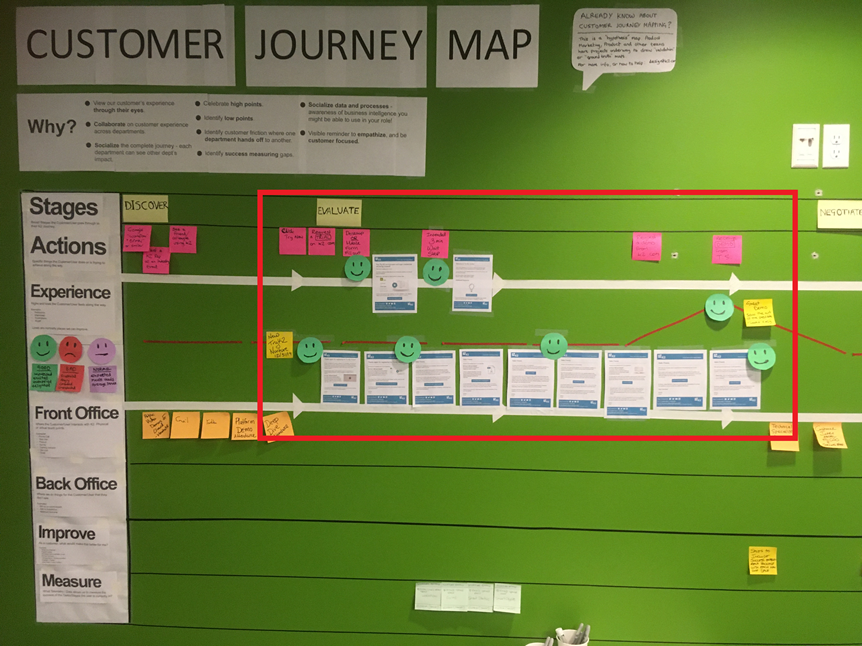Problem Statement
Understanding behavior patterns among our users was muddled. As an enterprise software, K2 has multiple personas that utilize our platform. As a user flows through the different buyer journey stages; awareness, evaluation, decision making, etc. We wanted to improve our understanding of specific user’s and their behaviors at the beginning stages of their journey in order to provide a more personalized trial and product experience.
My Role
I facilitated bi-weekly meetings with team members from sales, marketing, to look at our existing tools, map out a customer journey, and how to segment data into persona buckets. I also worked with the UX Lead to design a customer journey map on the wall between sales, marketing, and product to initiative a collaborative effort in building the map.
Tools Used
- Marketo
- Salesforce
- Google Analytics
- Vidyard
- Walkme
- Tape, makers, sticky notes, pens, etc.
- Markers, whiteboard
Goals & Hypothesis
My initial questions before beginning the project was;
- What are the various touchpoints where we do/can interact with users?
- Can we use our new product personas to understand customer behavior?
I wanted to better understand the earlier stages of the customer journey, before they reach the product, to see it early behavior can predict behavior in the product.
Hypotheses
- Understanding early phases of the customer journey will influence how to design our products.
- Our tools can be utilized more efficiently to fill in gaps of the current customer journey understanding.
- We will be able to test our new product personas for accuracy with data.
Research Methods
- Customer Journey Mapping
- Click Stream Analysis
- Personas
Timeframe
4 Sprints (approx. 2 months)
Personas
Previous to my time at K2, personas were created by our marketing and branding team to help tell a story of how these personas can us K2 to improve daily tasks at work. However, as we started segmenting users during this customer journey project, we noticed that our personas were expanding into multiple, specific user types. Previously, our personas were based off buyer behavior. With this project we were able to separate personas into buyers, users, and user types.
With the addition to our new personas focusing on product users, our Sr. Designer and I were able to interview experts (consultants, product managers, and other team members) to understand even further who these personas are.
There was a bit of a learning curve on the importance of tracking and understanding user demographics. I led workshops with the design team around how understanding user demographics can shape product decisions and future feature considerations. As a way to educate other product team members, the Sr. Designer designed posters of the personas that showcased demographics, paintpoints, goals, and product usage experience.
After spending a period of time with internal staff to build personas and learn about the different users, I wanted to test our personas for accuracy. This is when I began to reach out to our marketing and sales teams to get together to begin testing with our existing analytics tools.
Customer Journey Map
Before I could begin any efforts on segmenting our data by persona, I needed to understand what was even possible. What are we currently doing, what information currently exists, what tools are we currently using?
I worked with the UX Lead to design, first on whiteboard, a customer journey map that internal staff could fill in for me to answer the questions around, what is possible today?
We broke the customer journey down into multiple sections where people could fill in with sticky notes, any of the areas where they had information.
- Stages: We added in the multiple stages within the customer journey for people to orgsnization
- Actions: We wanted people to tell use what actions our users are doing within the different stages of the customer journey.
- Experience: This was an ever changing line of happy face and frowny faces based on user feedback from above actions.
- Front Office: What were people doing to interaction with users? What were the different touchpoints we had with users throughout the customer journey?
- Back Office: What tools/efforts are we doing to track these different touchpoints along the way
- Improve: Where do we feel we could improve the interaction with the user.
- Measure: Are we measuring and how are we measuring?
Segmentation
Finding out through the customer journey map what tools and initiatives we were currently doing, I gathered a team from marketing and sales to discuss how we improve our efforts. After our first meeting, we decided it was possible to use our existing tools to segment by persona.
I led a bi-weekly discussion to chart out how we can configure data in buckets that fit our personas. Our KPIs included;
- Search Queries
- Content consumption (video, whitepapers, emails)
- Type of influencer
- Job title/role
- Training courses (K2)
- Trial behavior
- Sales conversations (win/loss)
- Social Behavior
- Demographic info
We used the KPIs to map out how we could integrate our existing tools together to be able to observe and track a cohesive customer journey from end-to-end. Each meeting we also refined our reporting to come up with a potential scoring process that could segment users based on information gathered from each KPI.
Findings
The effort was to create a collaborative approach to discover new areas of opportunities, reveal and reduce customer pain-points, and unify our efforts across the company.
As people update the customer journey map, the product and design team continue to receive benefits of early user behavior and how it can be utilized for product decisions. Some key areas of successes include…
- New sample applications targeted towards specific user interests
- Eliminating multiple logins and allowing the user to only have a single login credentials across all K2 environments (website, trial, product, management, workspace, etc.)
- Reducing wait time for access to trial experience by changing a manual process to being automated.
- Improving efficiency of email campaigns, lead tracking, and marketing strategy.
Hypotheses
- Understanding early phases of the customer journey will influence how to design our products. Conclusive: We found many areas where the product could improve based on searches in help documentation, template designs, feature requests.
- Our tools can be utilized more efficiently to fill in gaps of the current customer journey understanding. Conclusive: We were able to effectively integrate all our analytics tools together to see customer insight up until signing into the product.
- We will be able to test our new product personas for accuracy with data. Inconclusive: We were able to begin segment our personas but not able to complete segmentation process. We could not validate if users fit product persona types.
Conclusion
We were continuing to solve the issue of integrating the data we collected from marketing analytics with product data. There are two separate environments and once a user logs in to our product, we are not able to correlate that with marketing data. We requested the use of a single environment (SSO) to be able to complete the customer journey insights.
Unfortunately, due to department restructuring and the companies response to COVID-19 initiatives, many of the team members working on this project no longer work at K2. The initiative has been put on hold until we can access the office again or allowed the resources to continue our efforts digitally.
Where I Could Improve
While I received mostly positive feedback about a collaborative approach to creating a customer journey map, not all the feedback was positive. By using the customer journey map to create cohesion and piece together gaps, some members were frustrated that it singled out inefficiencies and other problems within departments. Even though I received approval from my superiors to do the project, I did not ask for approval from other department managers. While approval was not needed, I will need to raise more awareness of any future cross-functional collaboration efforts.







